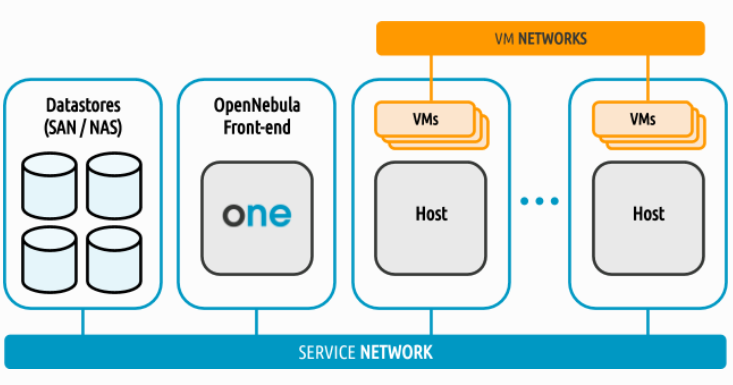virtualization
OpenNebula Virtualization Project
Project Overview
The OpenNebula Virtualization Project aimed to implement a scalable and reliable virtualization infrastructure using OpenNebula, an open-source cloud management platform. The architecture design involved a single frontend server managing multiple host servers to host virtual machines (VMs). Storage was handled using a file-based storage backend, and database services were distributed across three separate servers for redundancy, managed by alived.
Architecture:

Project Objectives
- Deploy a virtualization infrastructure using OpenNebula to enable efficient resource utilization and scalability.
- Ensure high availability and fault tolerance of virtual machines through redundancy and failover mechanisms.
- Implement centralized management and monitoring of VMs for streamlined administration.
- Integrate OpenNebula with existing infrastructure components for seamless operation.
Project Components
OpenNebula Frontend Server:
- Installed and configured OpenNebula frontend server to serve as the management interface.
- Configured user accounts, roles, and permissions for access control.
Host Servers:
- Provisioned multiple host servers to host virtual machines.
- Installed and configured hypervisor software (e.g., KVM) for VM management.
- Configured network settings for communication with the frontend server and VMs.
Storage Backend:
- Implemented file-based storage backend for storing VM images and data.
- Configured storage repositories for efficient allocation and management of storage resources.
Database Servers:
- Deployed three separate database servers managed by alived for redundancy.
- Configured database replication for data synchronization and failover handling.
Implementation Details
Architecture Design:
- Developed an architecture design document outlining the layout of components, including servers, networks, and storage.
Installation and Configuration:
- Documented step-by-step instructions for installing and configuring OpenNebula components, including frontend server, host servers, and database servers.
Integration with Existing Infrastructure:
- Integrated OpenNebula with existing network infrastructure and authentication systems for seamless operation.
Testing and Validation:
- Conducted thorough testing to validate the functionality, performance, and reliability of the virtualization infrastructure.
- Documented test cases, procedures, and results to ensure compliance with project requirements.
Project Deliverables
- Project Plan and Timeline: Detailed project plan outlining tasks, milestones, and timelines for project execution.
- Architecture Design Document: Documented architecture design illustrating the layout of components and their interactions.
- Installation and Configuration Guides: Step-by-step guides for installing and configuring OpenNebula components.
- Testing Plan and Results: Testing plan with documented test cases, procedures, and results.
- User Manuals: Manuals for administrators and end-users covering system usage, management, and troubleshooting.
Conclusion
The OpenNebula Virtualization Project successfully deployed a scalable and reliable virtualization infrastructure using OpenNebula. By leveraging OpenNebula’s features and integrating with existing infrastructure components, the project achieved its objectives of enhancing resource utilization, ensuring high availability, and streamlining management and monitoring processes.